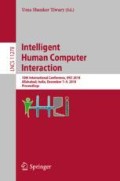Abstract
In India, there are many ancient pilgrimage sites with high religious significance. These sites experience a huge surge of crowd on auspicious occasions. The old infrastructure of these pilgrimage sites is not capable to accommodate present crowded situations. Nowadays, these sites are getting congested due to the encroachment on the nearby areas. These conditions make them vulnerable to tragic incidents. Modelling and simulation technology provides a platform to do the comprehensive assessment of architectural designs on different crowded situations. In this paper, we have created near to real virtual environment of an ancient pilgrimage site in an Agent Based Modelling tool. We have created intelligent agents that act, react and interact within this virtual environment. The crowd of intelligent agents are simulated for three different emergency evacuation scenarios and two different dimensions of gates. Subsequently, we explored the effect on emergency evacuation time with respect to dimensions of gates, location of gates and population size inside the temple. The simulation results establish the applicability of our methodology.
Access this chapter
Tax calculation will be finalised at checkout
Purchases are for personal use only
References
Almeida, J.E., Kokkinogenis, Z., Rossetti, R. J.: Netlogo implementation of an evacuation scenario. In: WISA 2012 (Fourth Workshop on Intelligent Systems and Applications), Madrid, Spain, 20–23 June 2012 (2012)
Axelrod, R.: Agent-based modeling as a bridge between disciplines. Handb. Comput. Econ. 2, 1565–1584 (2006)
Bandini, S., Manzoni, S., Vizzari, G.: Agent based modeling and simulation: an informatics perspective. J. Artif. Soc. Soc. Simul. 12(4), 4 (2009)
Chen, X., Zhan, F.B.: Agent-based modelling and simulation of urban evacuation: relative effectiveness of simultaneous and staged evacuation strategies. J. Oper. Res. Soc. 59(1), 25–33 (2008)
Daamen, W., Hoogendoorn, S.: Calibration of pedestrian simulation model for emergency doors by pedestrian type. Transp. Res. Rec. J. Transp. Res. Board 2316, 69–75 (2012)
Dias, C., Sarvi, M., Shiwakoti, N., Ejtemai, O., Burd, M.: Investigating collective escape behaviours in complex situations. Saf. Sci. 60, 87–94 (2013)
Escobar, R., De La Rosa, A.: Architectural design for the survival optimization of panicking fleeing victims. In: Banzhaf, W., Ziegler, J., Christaller, T., Dittrich, P., Kim, J.T. (eds.) ECAL 2003. LNCS (LNAI), vol. 2801, pp. 97–106. Springer, Heidelberg (2003). https://doi.org/10.1007/978-3-540-39432-7_11
Fruin, J.: Designing for Pedestrians. Public Transportation United States (1992)
Helbing, D., Molnar, P.: Social force model for pedestrian dynamics. Phys. Rev. E 51(5), 4282 (1995)
Helbing, D., Mukerji, P.: Crowd disasters as systemic failures: analysis of the love parade disaster. EPJ Data Sci. 1(1), 7 (2012)
Hoogendoorn, S., Daamen, W., Boer, A., Vaatstra, I.: Assessing passenger comfort and capacity bottlenecks in Dutch train stations. Transp. Res. Rec. J. Transp. Res. Board 2002, 107–116 (2007)
Ijaz, K., Sohail, S., Hashish, S.: A survey of latest approaches for crowd simulation and modeling using hybrid techniques. In: 17th UKSIMAMSS International Conference on Modelling and Simulation, pp. 111–116 (2015)
Illera, C., et al.: NO\_PANIC. “Escape and Panic in Buildings”–architectural basic research in the context of security and safety research. In: Klingsch, W., Rogsch, C., Schadschneider, A., Schreckenberg, M. (eds.) Pedestrian and Evacuation Dynamics. Springer, Heidelberg (2008). https://doi.org/10.1007/978-3-642-04504-2_71
Kasthala, S., Lakra, H.S.: Disaster preparedness for mass religious gatherings in India-learning from case studies. In: Second World Congress on Disaster Management (2015)
Santos, G., Aguirre, B.E.: A Critical Review of Emergency Evacuation Simulation Models (2004)
Shi, X., Ye, Z., Shiwakoti, N., Tang, D., Wang, C., Wang, W.: Empirical investigation on safety constraints of merging pedestrian crowd through macroscopic and microscopic analysis. Accid. Anal. Prev. 95, 405–416 (2016)
Shinde, K.: Religious Tourism and Religious Tolerance: Insights from Pilgrimage Sites in India, vol. 70 (2015)
Shiwakoti, N., Shi, X., Ye, Z., Liu, Y., Lin, J.: A comparative study of pedestrian crowd flow at middle and corner exits. In: The 38th Australasian Transport Research Forum (ATRF 2016), pp. 1–10. Australasian Transport Research Forum (2016)
Smith, E.R., Conrey, F.R.: Agent-based modeling: a new approach for theory building in social psychology. Pers. Soc. Psychol. Rev. 11(1), 87–104 (2007)
Still, G.K.: Introduction to Crowd Science. CRC Press, Boca Raton (2014)
Tolea, M.I., et al.: Sex-specific correlates of walking speed in a wide age-ranged population. J. Gerontol. Ser. B Psychol. Sci. Soc. Sci.65(2), 174–184 (2010)
Trivedi, A., Pandey, M.: Agent-based modelling and simulation of religious crowd gatherings in India. In: Bhattacharyya, S., Chaki, N., Konar, D., Chakraborty, U.K., Singh, C.T. (eds.) Advanced Computational and Communication Paradigms. AISC, vol. 706, pp. 465–472. Springer, Singapore (2018). https://doi.org/10.1007/978-981-10-8237-5_45
Wang, X., Li, J.: Study on the simulation models for pedestrian evacuation movement. Int. J. Digit. Content Technol. Appl. 7(8), 503 (2013)
Was, J., Lubaa, R.: Towards realistic and effective agent-based models of crowd dynamics. Neurocomputing 146, 199–209 (2014)
Westminister: Trimble juno series handhelds: Juno 3B and juno 3D, user guide (2012). https://gis14.uwec.edu/GeoSpatialResources/Manuals.htm
Wilensky, U.: Netlogo 5.2 (1999). https://ccl.northwestern.edu/netlogo/
Zhou, S., Chen, D., Cai, W., Luo, L., Low, M.Y.H., Tian, F., Tay, V.S.H., Ong, D.W.S., Hamilton, B.D.: Crowd modeling and simulation technologies. ACM Trans. Model. Comput. Simul. (TOMACS) 20(4), 20 (2010)
Author information
Authors and Affiliations
Corresponding author
Editor information
Editors and Affiliations
Rights and permissions
Copyright information
© 2018 Springer Nature Switzerland AG
About this paper
Cite this paper
Trivedi, A., Pandey, M. (2018). Towards Evaluating Architectural Design of Ancient Pilgrimage Site Using Agent Based Modelling and Simulation. In: Tiwary, U. (eds) Intelligent Human Computer Interaction. IHCI 2018. Lecture Notes in Computer Science(), vol 11278. Springer, Cham. https://doi.org/10.1007/978-3-030-04021-5_25
Download citation
DOI: https://doi.org/10.1007/978-3-030-04021-5_25
Published:
Publisher Name: Springer, Cham
Print ISBN: 978-3-030-04020-8
Online ISBN: 978-3-030-04021-5
eBook Packages: Computer ScienceComputer Science (R0)

